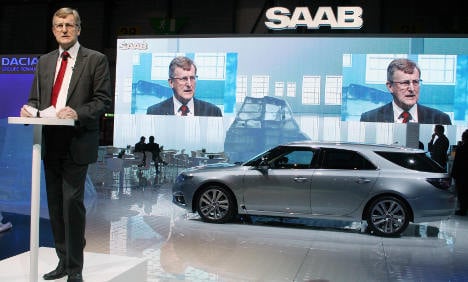A little over a year after it was saved at the eleventh hour by an unlikely Dutch suitor, Saab is back in familiar territory – short of sales, short of prospects and, most importantly, short of cash.
And just as in the weeks building up to the February 2010 sale of Saab by US GM to Dutch luxury car maker Spyker, one man has emerged as Saab’s knight in shining armour – Russian financier Vladimir Antonov.
Antonov, who made his fortune buying up post-Soviet banks, was widely reported to have been a stumbling block to GM’s sale of Saab to Spyker. It is reported that the US FBI put a stop to his involvement over rumours of links to money laundering and organized crime.
These rumours have been consistently dismissed by Antonov and his associates and the news on Thursday that GM and the National Debt Office (Riksgälden) had approved him as a new co-owner in Spyker, indicates that this is one of the few areas where the modern story of Saab appears to have changed.
“Saab enters a new era” was the headline that adorned The Local’s February 2010 article announcing an agreement between US General Motors (GM) and Dutch luxury sports car maker Spyker to transfer ownership of the western Sweden-based firm.
The agreement ended a long drawn out process involving GM, the Swedish government, the National Debt Office (Riksgälden) and the European Investment Bank (EIB).
The deal also signalled the end of a courting process involving a slew of potential suitors for the brand which, while commanding the affections of car-lovers across the globe, had long failed in the challenge of manufacturing cars sufficiently in demand in order to turn a profit.
A year later, it appears that the ownership change has had little impact on Saab’s fortunes.
“The only way to get a company to survive is to, with profit, build cars which people buy… You can’t carry on running losses, no company can, not even a car maker,” Sweden’s Prime Minister Fredrik Reinfeldt said on Tuesday.
Last February this simple fact was, however fleetingly, replaced by cautious hope as Spyker Cars’ flamboyant CEO Victor Muller received a hero’s welcome on a visit to Saab’s Trollhättan base with the ink barely dry on the sale.
“The interest in Saab is basically very easy to understand, Saab is an iconic brand,” Muller said at the time.
Victor Muller furthermore pledged that Saab’s future, crucial to the manufacturing sector in the city and in western Sweden, would remain very much connected to its Nordic home.
“The typical element of the Saab brand is its Swedishness…I think one would be very short-sighted to think that the Saab buyer would be very pleased to buy a Saab from Mumbai,” he added.
While the sceptics were many, the deal was a time for optimism, and shortly after the takeover was finalised on February 23rd the company issued a forecast that sales would rebound to around 60,000 vehicles during 2010.
This figure was revised down to 45,000 in August and when the the sum of the year’s efforts emerged in January 2011, the final figure stood at 32,048 cars sold. While this was in line with a further revision from October, and up 15 percent on 2009, it constituted barely half of that promised in the heady days of last spring.
Debts meanwhile continued to mount at Spyker Cars, and rumblings began over unpaid bills to suppliers at Saab.
Long-term head Jan Åke Jonsson resigned on March 25th, to be replaced by Victor Muller, who proceeded to describe the ongoing cashflow problems and initial production interruptions as “small glitches”.
But as the assembly lines ground to a more enduring halt, the deeper financial implications of Saab’s inability to sell enough vehicles to service its debts was laid bare.
Vladimir Antonov has throughout this period regularly featured in the news reporting surrounding Saab and Spyker and he has on several occasions stated his intention to assume control, with a concrete offer of financing made in mid-March 2011.
“It would be nice for Saab to have €50-70 million ($69-97 million) as a little something extra to lean on. We’re ready to provide that money if we’re allowed to do so by the EIB,” Antonov told the TT news agency.
Antonov said at the time that he saw no risk that the EIB loan, worth a potential €400 million, would be withdrawn if he was brought in as an owner.
“The EIB has fantastic security and a fantastic interest rate for the Saab loan. Why would they take it back?” he said.
Antonov has once again become the man in focus and the only prospect ready to stump up the cash to ensure Saab’s survival, in return for a portfolio of Saab property.
With this property forming part of the “fantastic security” to which Antonov refers to above the ball has been played back into the EIB’s and GM’s court.
During the recent troubles, the EIB has been accused of dragging its heels on releasing funds, GM of delaying on the approval of Antonov, and the Swedish government of being passive as Saab stands to be read its last rites.
So why is Saab so deserving of all the attention and why does a firm that has not made a profit in decades warrant survival?
Estimates vary but it is reported that some 8,000-10,000 jobs are at risk in western Sweden if Saab were to fall into bankruptcy. The immediate impact on Swedish GDP has been put at 0.2 percent.
The political risks are somewhat lower than they were in the beginning of 2010, when the Alliance government was languishing in the opinion polls with an election looming. The job losses would be considerable however and would serve to undermine one of the cornerstones of the government’s election success.
While unions have been quick to accuse the government of inaction, there has however been recognition that the political options are few.
In March, Saab announced that Australian blogger Steven Wade had been recruited to the company’s social media marketing team as reward for running the independent Saabs United blog from his Melbourne home.
“It is a given that you have played a key role in saving Saab last year by mobilizing tens of thousands of enthusiasts to rally in support of the company,” Victor Muller wrote in a letter to Wade posted on the site.
But as Saab factories remain at a standstill, the firm’s battle-weary workers remain idle and the prospect of bumper sales a distant prospect, this one-time flagship of Swedish industry will need more than enthusiastic fans to establish a future in the cutthroat global automotive industry.
As motor industry analyst and Dagens Nyheter journalist Lasse Svärd told the broadcaster TV4 this week, the 270 million kronor ($44 million) raised by the sale of Saab’s properties is no long-term financing solution.
“It sounds like quite a lot, but this is small change in the context of the car industry. It’ll last Saab a couple of weeks,” he said.




 Please whitelist us to continue reading.
Please whitelist us to continue reading.
Member comments